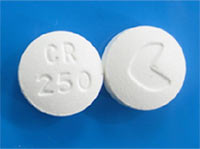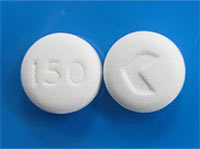Reminder: Pay Attention to the Appearance of Your Medicines
2014-12-02
Are you familiar with the identifying marks on your medicines? Do you pay attention to the appearance of medicines you give to your children or other family members? An incident report received by SafeMedicationUse.ca illustrates why being able to answer "yes" to these questions can be important.
An elderly consumer received a prescription for the antibiotic ciprofloxacin to treat a lung infection. This consumer also took ranitidine when needed for indigestion. While the consumer was having the prescription for ciprofloxacin filled at the pharmacy, she also requested a refill of her prescription for ranitidine.
Six days after having these prescriptions filled, the consumer took a tablet from the bottle labelled "ranitidine" and noticed that it was marked with the number "250". The consumer knew that her ranitidine tablets were usually marked with the number "150" (see figure 1). The consumer realized that a mistake might have been made. She took the medicine vials back to pharmacy, where the pharmacist confirmed that the labels had been swapped when the prescriptions were filled. This mistake meant that the vial labelled "ranitidine" actually contained ciprofloxacin (the antibiotic for the consumer’s infection), and the bottle labelled "ciprofloxacin" actually contained ranitidine (the drug for indigestion). As a result, for 6 days, the consumer had been taking three ranitidine tablets a day, and she had not taken any ciprofloxacin.
|
Figure 1: Images of Ranitidine 150 mg and Ciprofloxacin 250 mg tablets from manufacturers Sivem and Cobalt, respectively; note the differences in identifying marks. These images do not necessarily reflect the tablets involved in this incident.
 - Ciprofloxacin 250 mg
 - Raniditine 150 mg
|
Because the consumer did not take any antibiotic for almost a week, her lung infection lasted longer than expected. The consumer also worried that she had taken a lot more ranitidine than her doctor intended. On the plus side, the consumer noticed the error within a few days, and the problem was corrected. Being aware of her medicine's markings helped to protect her health and ensured that she started taking the correct treatment for her illness.
We all know that mistakes can happen. SafeMedicationUse.ca has the following suggestions for preventing harm from mistakes like this one:
- Always check your prescriptions before you leave the pharmacy. If anything looks different from what you were expecting, speak with a member of the pharmacy staff. Do not take any doses of the medicine until your concerns have been addressed.
- Be familiar with the appearance of any medicines that you take. Take note of the medicine's size, colour, shape, and any markings in the form of letters/numbers/scoring. If a medicine that you take regularly seems to have a different appearance than before, speak with a member of the pharmacy staff or another healthcare provider before taking any doses.
- Whenever you receive a prescription for a new medicine, review the details with your prescriber. Take note of details such as the name and strength of the medicine, how much to take, and how often to take it. Know whether the medicine is to be swallowed or taken some other way. Add this information to your list of medicines along with information on the appearance of your medicine.
Read more about checking your prescription.
|
Tips for Practitioners:
- Count and label only one prescription at a time. When 2 prescriptions are being prepared and a "basket system" is in place, leave the second prescription in a basket until the first prescription has been counted and labelled.
- During the checking process, confirm that the appearance of the medicine contained in the patient's vial matches the appearance of the medicine in the manufacturer's bottle and that the vial is labelled appropriately.
- Keep patients informed about any changes to the appearance of their medicines. When there has been a change in the appearance of a patient's medication because of a change in stocked medication or a generic substitution, use appropriate auxiliary labelling and notify the patient at the time of prescription pick-up.
- Use patient consultation as the final checkpoint in the process. When talking with consumers about appropriate use of their medicines, open the prescription containers and review the product appearance. This will allow you and the consumer to check the appearance of each medicine and identify any discrepancies before the consumer leaves the pharmacy.
|
|

